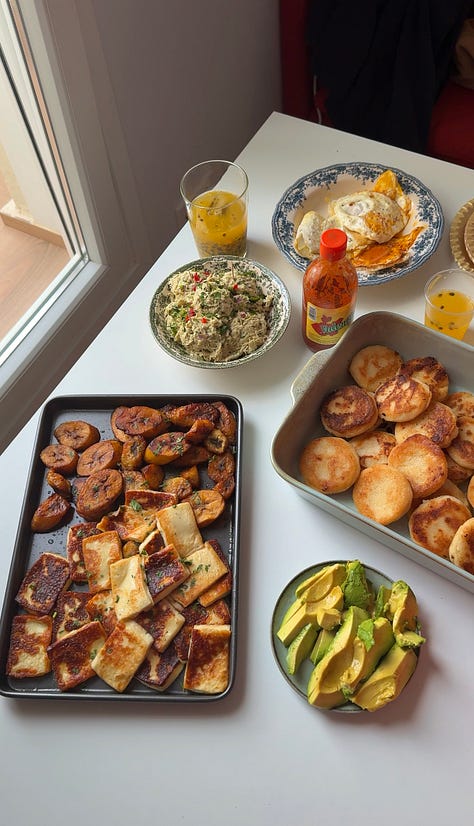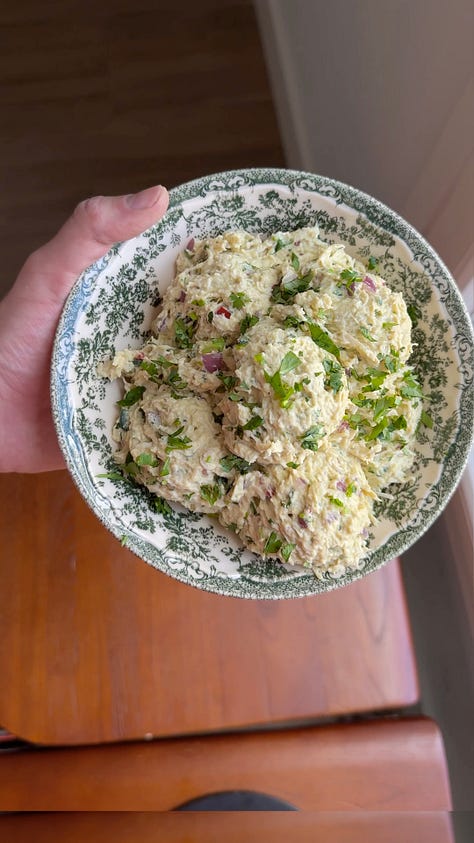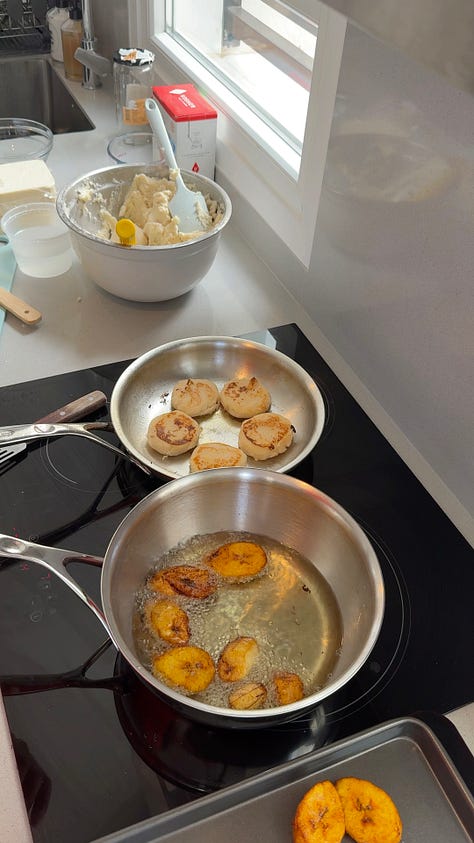Arepas with Reina Pepiada (Venezuelan Chicken Salad with Avocado)
How to have a large-batch arepa party!
From my good friend, former roommate, and food scientist Andrea Gómez:
Arepas are a staple of both Venezuelan and Colombian diets. There are many varieties. This is just how my family makes them. If you are unfamiliar with arepas, they are almost like an English muffin, except made out of pre-cooked cornflour. My go-to brand of masarepa (the type of flour) is called Harina P.A.N., and it’s available at MANY major grocery stores (you’d be surprised).
Having a Venezuelan dad meant eating arepas at least twice a week when I was home. I would love to wake up on Sunday to freshly made arepas. What I love the most about them is that you can fill them up with whatever you want. My personal favorites include fried egg, queso blanco (even better if fried) and avocado.



The most popular fillings include:
De queso (with cheese)
Reina Pepiada: shredded chicken with avocado and mayonnaise
Sifrina: Reina Pepiada with cheese
La Pelúa: Carne Mechada (shredded beef) and cheese
La Catira: shredded chicken and cheese
I would always eat them for breakfast, but you can eat them any time! They are super versatile and easy to make.
When I left for college, I found myself missing arepas, so I learned how to make them myself. Arepa brunches became a regular thing in my apartment, and I was lucky enough to share them with my closest friends and roommate (Jeremy!).
Every household makes these differently, some add flour first, others do water. Do whatever works for you! Don’t take the recipe too seriously, I usually eyeball it and you’ll get better every time you make them. I am sharing the recipe my grandmother taught me. I hope you make arepa brunches your thing too, I can assure you’ll love them.
It’s hard to beat arepas for a weekend brunch, and the filling possibilities are endless. “Reina Pepiada” is the most popular filling for Venezuelan-style arepas, named for the first Venezuelan winner of the Miss Universe competition. It’s a light and fresh chicken salad always made with avocado and a bit of mayonnaise — and typically made also with cilantro, garlic, and minced onion. While you can use leftover rotisserie chicken for this recipe, I am including how to poach chicken breast from scratch.
Ingredients to poach the chicken:
Three chicken breasts
1 chicken bouillon cube (or a teaspoon of Better than Bouillon)
1 tablespoon Diamond Crystal Kosher Salt (or 1.5 teaspoons Morton’s)
4 garlic cloves, smashed
1 jalapeño, cut in half
Ingredients for the filling:
3 cooked chicken breasts (from above)
1-2 tablespoons chicken broth (optional; from above)
1 ripe avocado
1/4 cup mayonnaise
1/2 red onion, minced
2 tablespoons minced fresh cilantro
1-2 jalapeños, minced (use more or less according to your taste)
1 lime
Kosher salt and freshly ground black pepper to taste.
Method:
Place the chicken breasts to a medium-large pot and cover with cold water. Add the chicken bouillon cube with the salt, smashed garlic and jalapeño. Bring the pot to a boil over medium-high heat, then reduce to a low simmer. Simmer 20 minutes, then cut the heat and let the chicken sit in the broth 10 more minutes before shredding.
Add the cooked chicken to a large mixing bowl (I use a stand mixer), and shred it finely. You can do this with two forks, a hand mixer, or the whisk attachment of a stand mixer.
I like to add 1-2 tablespoons of the warm broth leftover from cooking the chicken. Then add the avocado and mayonnaise and mix mash it well into the chicken.
Mix in the minced red onion, cilantro, minced jalapeño, juice of 1 lime—and kosher salt and freshly ground black pepper to taste.
When everything is mixed and well-seasoned, cover and refrigerate until serving.
For the arepa dough:
4 cups Harina P.A.N. (special pre-cooked corn flour specifically for making arepas)
5 cups water
2 tablespoons Diamond Crystal kosher salt
1 cup grated parmigiano reggiano (optional - some families add, many don't)
Method:
Preheat your oven to 375° F.
In a medium bowl, add the flour and salt, slowly incorporate water while kneading (I always use my hands) until a smooth dough is formed.
Using wet hands to prevent the dough from sticking, take a handful of the dough and shape into a small ball, then slowly press with both of your hands to form a patty. (Thickness and size depend on your personal liking, but a 1/4 cup scoop makes a nice mini-arepa)
Place into a griddle or frying pan with a little bit of oil to prevent them from sticking, it will take approximately 5 minutes per side on medium heat. You can also get an arepa maker and get perfect arepas every time. After they are cooked on each side, and in between batches, I like to put all the cooked arepas on a large sheet tray in the oven. This helps them continue to get crispy on the outside—they still stay fluffy on the inside—and it keeps them warm so you can serve all at once.
Cut the arepa 3/4 of the way around, leaving a seam on the edge so you can fill it.
You can store your leftover arepas in the fridge for 3-4 days; reheat them in the oven or toaster.



